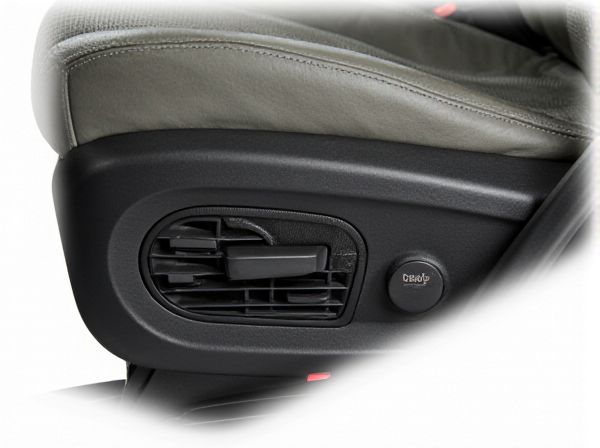
Photo illustration: Heated Seat vs Ventilated Seat
Heated seats provide warmth during cold weather by using built-in heating elements that quickly increase the seat temperature, enhancing comfort on chilly days. Ventilated seats circulate air through perforations to keep you cool and reduce sweating in hot conditions, improving overall driving comfort. Choosing between heated and ventilated seats depends on your climate and personal preference for temperature control in your vehicle.
Table of Comparison
| Feature | Heated Seat | Ventilated Seat |
|---|---|---|
| Function | Provides warmth by heating seat surface | Enhances comfort by circulating cool air through seat |
| Ideal Use | Cold weather driving | Hot and humid weather |
| Energy Consumption | Moderate (uses electric heating elements) | Higher (uses fans and ventilation system) |
| Comfort Level | Offers immediate cozy warmth | Provides ongoing cooling and moisture reduction |
| Common in | Luxury and mid-range vehicles | Premium vehicles and higher trims |
| Maintenance | Low (simple heating wires) | Moderate (fans may require cleaning) |
Introduction to Heated and Ventilated Seats
Heated seats use embedded electrical elements to generate warmth, providing comfort in cold weather by instantly raising the seat temperature. Ventilated seats incorporate fans or channels within the seat cushion and backrest to circulate air, reducing heat and moisture buildup for enhanced cooling during hot conditions. Both systems enhance driving comfort by regulating seat temperature tailored to different climate needs.
How Heated Seats Work
Heated seats utilize electric heating elements embedded within the seat cushion and backrest to generate warmth, providing comfort during cold weather. These elements are controlled by a thermostat that adjusts the temperature based on user settings or ambient conditions, ensuring consistent heat distribution. The heat transfers directly to the occupant, improving comfort and reducing the need for excessive cabin heating.
How Ventilated Seats Operate
Ventilated seats operate using small fans embedded within the seat cushions that circulate air through perforations in the leather or fabric, effectively cooling the occupant by promoting airflow and reducing sweat buildup. Unlike heated seats that rely on electrical heating elements to provide warmth, ventilated seats use active ventilation technology to improve comfort in hot weather by dissipating heat and moisture. This system enhances comfort in warm climates by maintaining a cooler seating surface and preventing discomfort caused by trapped heat.
Comfort Comparison: Warmth vs. Cooling
Heated seats provide focused warmth by using built-in heating elements that rapidly increase seat temperature, enhancing comfort in cold weather. Ventilated seats circulate air through perforations in the upholstery, effectively dissipating heat and moisture to maintain a cool and dry seating surface during hot conditions. The choice between heated and ventilated seats depends on individual comfort needs related to temperature regulation, with heated seats excelling in cold climates and ventilated seats offering superior cooling in warm environments.
Climate Considerations: When Each Seat Shines
Heated seats excel in cold climates by providing rapid warmth and comfort during winter months, effectively reducing discomfort from freezing temperatures. Ventilated seats are ideal for hot and humid environments, enhancing airflow and moisture evaporation to keep occupants cool and dry. Choosing between heated and ventilated seats depends heavily on regional climate patterns and personal comfort preferences.
Health Benefits and Drawbacks
Heated seats improve circulation and relieve muscle tension by providing gentle warmth, which can be beneficial in cold climates or for individuals with arthritis. Ventilated seats enhance comfort by promoting airflow, reducing sweat and skin irritation, thus lowering the risk of heat rash or bacterial growth during hot weather. Overuse of heated seats may cause skin dryness or burns, while poorly maintained ventilated seats can accumulate allergens or dust, potentially triggering respiratory issues.
Energy Efficiency and Impact on Fuel Economy
Heated seats typically consume less energy than ventilated seats because they use resistive heating elements that require relatively low power. Ventilated seats rely on electric fans to circulate air, which can draw more power and potentially reduce fuel economy, especially in vehicles without efficient electrical systems. Choosing heated seats over ventilated ones can contribute to marginally better energy efficiency and less impact on overall fuel consumption.
Maintenance and Longevity Differences
Heated seats rely on electrical heating elements that require regular inspection to prevent wiring issues and ensure consistent warmth, while ventilated seats use fans and air channels that need cleaning to avoid dust buildup and maintain airflow efficiency. Ventilated seat systems may have more frequent mechanical wear due to moving parts, potentially leading to earlier maintenance needs compared to the simpler heated seat components. Proper maintenance of both types extends longevity, but heated seats often have fewer repair costs as they lack mechanical parts prone to failure.
Cost Analysis: Initial Investment and Upkeep
Heated seats typically incur a lower initial investment compared to ventilated seats due to simpler heating elements and installation processes. Ventilated seats require more complex systems with fans or air channels, increasing both upfront costs and potential maintenance expenses. Long-term upkeep for heated seats mainly involves electrical system checks, while ventilated seats may demand additional repairs to mechanical components, leading to higher overall maintenance costs.
Which Seat Type Is Right for You?
Heated seats provide warmth by using electrical heaters embedded in the seat, ideal for colder climates or individuals sensitive to cold. Ventilated seats circulate air through perforations to cool the occupant, making them perfect for hot weather or those prone to sweating. Choosing between heated and ventilated seats depends on your typical climate conditions and personal comfort preferences for temperature control.
 caratoz.com
caratoz.com